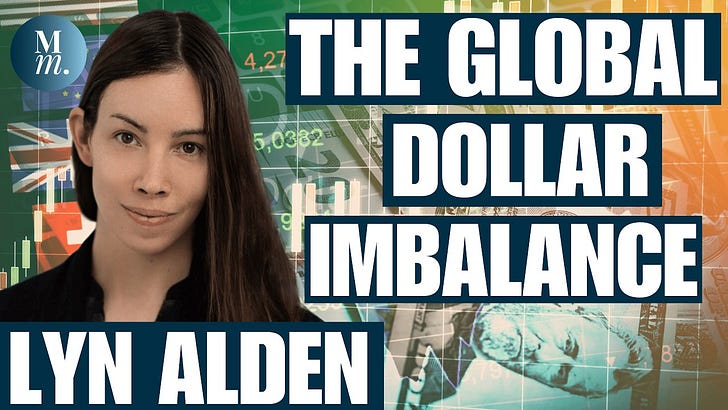Special message from Bill Cara on April 6
This week’s report is critical, especially if you have investments exposed to current market risks. At 590 pages, I know it’s a lot to digest, but the analysis inside reflects the serious challenges I’ve been highlighting over the past several weeks.
If you haven’t been following closely, now is the time to do so. The stakes are high, and this report can help people navigate what’s ahead.
Please feel free to share it with anybody.
If you have been following my work, you already know I attribute a lot of my learning to Bill Cara and his work. He is relaunching an extensive Weekly report that covers the entirety of the market, and it is over 300 pages long with institutional level insight with a macro lens on the global machine that is the “Market”.
When Bill used to publish these weekly reports I initially understood a very small percentage of the report. I slowly began to chip away and tried to learn and much as I could week to week, researching the topics I did not understand. I then began to question him and do my own research on why Bill said certain things or why he was focusing on a particular piece of the jigsaw puzzle.
Here is the latest AI generated podcast that summarizes the full report. At over 300 pages this macro view of the global markets is institutional level content and is only available to premium subscribers moving forward. Eventually this will be a paid service at Billcara.com, and our audience here will get a discount.
Briefing Doc
This briefing document summarizes the main themes, important ideas, and key facts presented in the provided excerpts from "Navigator Report 13.pdf". The report covers a wide range of investment topics, including global market performance, fixed income analysis, commodity trends, and specific country investment profiles.
1. Global Market Performance and Currency Trends:
The report provides a snapshot of currency movements, highlighting percentage changes for various currency pairs, primarily against the Australian Dollar.
Currencies showing significant gains against the Australian Dollar include the US Dollar, Swiss Franc, Japanese Yen, and Euro. For example, "$USDAUD - US Dollar to Australian Dollar 1.66 0.07 4.72%".
Conversely, the Australian Dollar has weakened against several currencies, as seen in pairs like "$AUDJPY - Australian Dollar to Japanese Yen 88.78 -3.74 -4.04%".
This currency data likely serves as a starting point for analyzing international investment opportunities and potential hedging strategies.
2. Government Bond Prices & Yields:
The report analyzes trends in US and foreign treasury bond yields for the week ending March 22nd.
US Treasury Bonds: Recession fears led to a decrease in the 10-year US Treasury yield to 4.32% on March 14th.
European Bonds:Germany's 10-year yield increased to 2.93% (March 13th) due to "increased spending plans," which fostered "positive investor sentiment regarding fiscal policies."
UK gilt yields rose to 4.67% (March 14th) driven by "inflation concerns" leading to "continued volatility tied to persistent inflationary pressures."
Japanese Bonds: Japanese government bond yields increased to 1.53% (March 14th), "reflecting rate hike speculations."
The report emphasizes the varied trends in global bond markets, heavily influenced by "regional economic factors and central bank actions," and advises investors to "remain cautious amid fluctuating yield levels and prepare for potential shifts in market sentiment."
3. Commodity Markets Performance:
The report reviews commodity market performance for the week ending March 23rd, showing significant declines across various sectors.
The "Commodidollar Index (NBD)" saw a substantial decrease of -4.55%.
Energy commodities experienced significant drops, with the "Oil Index - NYSE Arca" ($XOI) down by -8.71% and the "Natural Gas Index - NYSE Arca" ($XNG) falling by -8.46%. The "Oil Services Index - Philadelphia" ($OSX) recorded a steep decline of -11.21%.
Agricultural and livestock indices also showed losses, for instance, the "$GKX - S&P GSCI Agricultural Index - Spot Price" was down -2.54%.
Precious metals saw more moderate declines, with "$GOLD - Gold - Continuous Contract (EOD)" down -2.22% and "$SILVER - Silver - Continuous Contract (EOD)" falling by -6.74%.
Industrial metals also experienced negative performance, with the "$GYX - S&P GSCI Industrial Metals Index - Spot Price" down -4.81% and the "Global X Copper Producers Index ETF" (COPP.TO) plummeting by -10.52%.
4. US Dow Indexes (DJIA, DJTA, DJUA) and Dow Theory:
The report explains Dow Theory, highlighting that the three Dow indexes (Industrial Average, Transports Average, and Utilities Average) "combine to underlie the Dow Theory," which has a "legitimate foundation as a reflection of asset valuation– the US economy- unlike cryptocurrency."
It details the significance of each index:
DJIA: Benchmark of the broader US economy.
DJTA: Assesses the condition of the US economy by tracking prominent transport companies, as "goods producers must deliver goods to consumers."
DJUA: Measures the performance of utility companies and provides another benchmark for the US economy, as "the economy relies on power from utility company producers to consumers."
The report outlines the three types of trends in Dow Theory:
Primary Trend (Major Trend): Lasts 1–3 years (bull or bear market), most critical for long-term investors.
Secondary Trend (Intermediate Reaction): Corrections within the primary trend, lasting 3 weeks to 3 months, retracing 33–66% of the prior move.
Minor Trend (Noise): Short-term fluctuations (days/weeks), considered unreliable for decision-making.
An "Outlook" section suggests the "Dow may test 36,000 if trade tensions escalate" and warns that "Recession risks rise if tariffs persist beyond Q2."
Performance data for the Dow 30 components for the week ending April 4, 2025, shows predominantly negative returns across various timeframes (week, month, quarter, half-year, year, year-to-date).
5. Investing in Specific Countries and Regions:
The report includes sections dedicated to investing in various countries and regions, offering insights into their economies, key industries, and potential investment considerations.
Europe: Lists sections on "Investing in the Best of Europe," followed by specific countries like France, Germany, Italy, Spain, Netherlands, Nordic Countries, Switzerland, and the United Kingdom.
South Asia and Asia-Pacific: Includes sections on the broader region and specific countries like India, Australia and New Zealand, Japan, Singapore, Hong Kong, and China.
Emerging World: A section dedicated to investment in the emerging world.
Specific Country Insights (Examples):
United Kingdom: Described as a "global financial powerhouse" with sophisticated capital markets and a diversified economy. Key industries include "financial services, pharmaceuticals, and automotive production." Investors are directed to Investing.com UK's Market Overview for detailed information.
India: Highlights the NIFTY as the "usable benchmark NSE index" and BANKNIFTY for the banking sector. Mentions INDIAVIX as India's volatility index.
Japan: Suggests "Avoid exporters" due to the yen's safe-haven status potentially hurting them and reliance on US/EU markets. Favors "domestic consumption and defensive sectors" due to policy uncertainty and the Bank of Japan's reluctance to hike rates despite inflation.
Netherlands: Characterized by a "sophisticated capital market and regulatory system," a strong industrialized economy, and significant agricultural exports. Leading industries include "engineering, chemicals, and microelectronics."
Nordic Countries: Includes a breakdown of investment exposure by country within the Nordic region (Sweden, Norway, Finland, Denmark). Mentions "Warnings in the Nordic markets" based on chart patterns.
France: Provides lists of large-cap French stocks trading in Euro on the Paris Exchange and their corresponding US tickers.
Germany: Lists prominent German companies trading on the Frankfurt Stock Exchange and their US tickers.
6. Sector-Specific Analysis:
The report delves into specific sectors, providing watchlist performance, technical outlooks, and background information.
Goldminer Stocks: A watchlist with trading performance and short-term technical outlook is presented. Key gold producers are listed.
Silverminer Stocks: Similar analysis is provided for silver miners, noting a shift from "neutral to a bit bearish" technical picture.
Industrial Stocks: A watchlist and background on bellwether industrial companies are included, emphasizing that "Established industrial giants often provide steady dividends and repurchase shares during strong cycles."
Consumer Discretionary Stocks (XLY Studies): Notes an "excruciating week for consumer stocks" linked to tariff news. Highlights Home Depot (HD) as a key player in the sector due to its omnichannel strategy and strong relationships.
7. Technical Analysis Concepts:
The report briefly introduces technical analysis, covering Moving Averages (Simple Moving Average) as a "foundational tool" with buy/sell signals based on price relative to the MA.
It lists "Key indicators" such as RSI, Stochastic, MACD, ADX, Williams %R, CCI, and ATR, each generating buy, sell, or neutral signals.
A "Scoring System" is described that combines signals from moving averages and indicators to generate an overall rating (Strong Buy to Strong Sell).
8. Portfolio Diversification and Stock Lists:
The "Cara 100 Diversification" section provides a breakdown of a model portfolio by sector, highlighting a significant allocation to "Technology" (23%), "Energy" (13%), and "Industrials" (13%).
A "Cara 100 Finviz Screener" list includes numerous stock tickers across various sectors.
Lists of "Best of Europe" companies and "Best of the Rest" international company stocks are provided, often with industry classifications and assessments of their strengths.
9. Options Trading and Emerging Markets:
Briefly introduces "Put and Call Options" as derivative contracts.
A list of "South American market Indices" with links to charts is provided.
A table lists various prominent South American company stocks with their country and tickers.
10. Global ETFs and Indices:
The report frequently references various global stock market indices and Exchange Traded Funds (ETFs) for different countries and regions.
It provides lists of Netherlands, Nordic, and other country-specific indices and ETFs, often with their ticker symbols and links to financial platforms like Yahoo Finance and Investing.com.
A comprehensive "Country ETF List" at the end provides tickers for iShares and other ETFs tracking specific country markets.
Key Takeaways and Implications:
The report provides a broad overview of global financial markets, covering equities, fixed income, currencies, and commodities.
Geopolitical factors, such as trade tensions and fiscal policies, are highlighted as significant drivers of market movements.
Central bank actions and inflation concerns continue to influence bond yields and investor sentiment.
Sector-specific analysis offers insights into the performance and outlook of key industries.
The inclusion of technical analysis concepts suggests a consideration of both fundamental and technical factors in investment decisions.
The extensive lists of individual stocks, ETFs, and indices provide a starting point for further research and investment exploration across various international markets.
This briefing document provides a foundational understanding of the information contained in the "Navigator Report 13.pdf" excerpts. Further detailed analysis of specific sections and data points is recommended based on individual investment interests and strategies.
Study Guide
Key Concepts
Global Investing: The practice of investing in assets located outside of one's home country.
Developed Markets: Countries with established and mature economies and financial systems (e.g., US, UK, Japan, Germany, Australia).
Emerging Markets: Countries with developing economies and financial systems, often characterized by higher growth potential but also higher risk (e.g., Brazil, India, China).
Foreign Exchange (Forex): The market in which currencies are traded. Currency exchange rates can significantly impact international investment returns.
Exchange Rate: The value of one currency expressed in terms of another.
Appreciation: An increase in the value of a currency.
Depreciation: A decrease in the value of a currency.
Government Bonds (Treasury Bonds): Debt instruments issued by national governments to finance their spending. Bond yields are influenced by economic conditions and central bank policies.
Bond Yield: The return an investor receives from a bond, expressed as a percentage of its market price.
Inflation: A general increase in prices and fall in the purchasing value of money.
Central Bank: The institution responsible for managing a country's currency and monetary policy.
Interest Rates: The cost of borrowing money, influenced by central bank policies and economic conditions.
Dow Theory: A financial market theory that describes and predicts market trends based on the combined performance of the Dow Jones Industrial Average (DJIA), the Dow Jones Transportation Average (DJTA), and the Dow Jones Utility Average (DJUA).
Primary Trend (Major Trend): Long-term movement of the market lasting 1-3 years.
Secondary Trend (Intermediate Reaction): Corrections within the primary trend, lasting 3 weeks to 3 months.
Minor Trend (Noise): Short-term fluctuations in the market lasting days or weeks.
Technical Indicators: Mathematical calculations based on price and volume data used to identify potential trading signals (e.g., RSI, MACD).
Moving Average (MA): The average price of a security over a specific period, used to smooth out price fluctuations.
GICS (Global Industry Classification Standard): A standardized system for classifying stocks into sectors and industries.
Consumer Discretionary Stocks: Stocks of companies that sell non-essential goods and services. Their performance is sensitive to economic cycles.
Derivatives: Financial contracts whose value is derived from an underlying asset (e.g., options).
Put Option: A contract that gives the buyer the right, but not the obligation, to sell an underlying asset at a specified price within a specific time frame.
Call Option: A contract that gives the buyer the right, but not the obligation, to buy an underlying asset at a specified price within a specific time frame.
ADR (American Depositary Receipt): A certificate issued by a U.S. bank representing shares in a foreign stock traded on a U.S. exchange.
ETF (Exchange Traded Fund): A type of investment fund that holds a basket of assets (like stocks or bonds) and trades on an exchange like a stock.
Indices: A statistical measure of the performance of a group of securities, often representing a particular market or sector (e.g., NIFTY, DAX, AEX).
Commodity Markets: Markets where raw materials (like oil, gold, and agricultural products) are traded.
Short Answer Quiz
Explain the fundamental difference between investing in developed markets and emerging markets, highlighting a key risk and potential reward associated with each.
How can fluctuations in currency exchange rates impact the returns of an international investment for a U.S.-based investor? Provide a brief example.
Describe the significance of government bond yields as an indicator of economic sentiment and potential future central bank actions within a specific country.
According to Dow Theory, what distinguishes a primary trend from a secondary trend in the stock market, and why is this distinction important for long-term investors?
What is the purpose of using technical indicators in stock analysis, and can you name two commonly used indicators mentioned in the source material?
Explain the concept of consumer discretionary stocks and why their performance is often considered a gauge of economic health.
What is the core difference between a put option and a call option, and what right does each type of option grant to its buyer?
Define what an American Depositary Receipt (ADR) is and explain its function in facilitating international stock trading for U.S. investors.
What is an Exchange Traded Fund (ETF), and what are some of the benefits of using ETFs to gain exposure to international markets or specific sectors?
Briefly describe the role of indices like the NIFTY in India or the DAX in Germany in understanding the performance of their respective stock markets.
Answer Key
Developed markets have mature economies with lower growth potential but also generally lower investment risk due to stable political and economic systems. Emerging markets, conversely, offer higher growth potential but come with greater risk due to factors like political instability and currency volatility.
Currency exchange rate changes can either enhance or diminish the returns for a U.S. investor. For example, if a U.S. investor holds Euro-denominated stocks and the Euro appreciates against the U.S. Dollar, the returns will be higher when converted back to USD.
Government bond yields reflect investor confidence in the government and the economy; rising yields can indicate expectations of higher inflation or interest rate hikes, while falling yields may signal recession fears or expectations of lower rates.
A primary trend is a long-term, major market movement (bull or bear) lasting 1-3 years, while a secondary trend is a shorter-term correction within the primary trend, lasting 3 weeks to 3 months. Understanding the primary trend is crucial for long-term investors to align their investment strategy with the overall market direction.
Technical indicators are used to analyze historical price and volume data to identify patterns and generate potential buy or sell signals. Two commonly mentioned indicators are RSI (Relative Strength Index) and MACD (Moving Average Convergence Divergence).
Consumer discretionary stocks represent companies selling non-essential goods and services, such as entertainment, travel, and luxury items. Their performance tends to rise during economic expansions when consumers have more disposable income and fall during economic contractions.
A put option gives the buyer the right to sell an underlying asset at a specific price by a certain date, while a call option gives the buyer the right to buy an underlying asset at a specific price by a certain date. Option buyers are not obligated to exercise these rights.
An ADR is a certificate issued by a U.S. bank that represents shares of a foreign company held by the bank. It allows U.S. investors to easily buy and sell shares of foreign companies on U.S. stock exchanges in U.S. dollars.
An ETF is a fund that trades on stock exchanges and typically tracks the performance of a specific index, sector, or asset class. Benefits include diversification, liquidity, and lower expense ratios compared to some mutual funds, providing easy access to various international markets.
Indices serve as benchmarks to measure the overall performance of a stock market or a specific segment of it. The NIFTY, for example, reflects the performance of the top 50 companies in India, while the DAX tracks the 40 largest listed companies in Germany.
Essay Format Questions
Discuss the factors that investors should consider when deciding to allocate a portion of their portfolio to international investments, referencing both potential benefits and inherent risks as highlighted in the provided source material.
Compare and contrast the economic and market conditions described in the excerpts for two different European countries (e.g., Germany and the United Kingdom), analyzing how these conditions influence investment decisions in their respective government bond markets.
Analyze the principles of Dow Theory as outlined in the text, evaluating its relevance and applicability for modern investors seeking to understand and profit from long-term market trends in a globalized economy.
Based on the provided information, discuss the importance of understanding sector-specific trends (e.g., consumer discretionary, industrials, gold miners) when making international investment decisions, and provide examples of how macroeconomic factors or global events might impact these sectors differently.
Evaluate the different methods available to U.S. investors for gaining exposure to international equity markets, such as investing in individual ADRs or through broad-based or country-specific ETFs, considering the advantages and disadvantages of each approach.
Glossary of Key Terms
Asset Valuation: The process of determining the current worth of an asset or company.
Bull Market: A period of rising stock prices and optimistic market sentiment.
Bear Market: A period of declining stock prices and pessimistic market sentiment.
Fiscal Policies: Government actions related to spending and taxation to influence the economy.
Monetary Policy: Actions undertaken by a central bank to manipulate the money supply and credit conditions to stimulate or restrain economic activity.
Commodity Costs: Expenses related to raw materials used in the production of goods and services.
Pricing Power: The ability of a company to raise prices without significantly impacting demand.
Regulatory Framework: The set of rules, laws, and guidelines established by government bodies to govern an industry or market.
Dividend Yield: The annual dividend payment of a stock as a percentage of its current market price.
Market Sentiment: The overall attitude of investors towards a particular security or market.
Due Diligence: The process of conducting thorough research and analysis before making an investment.
Arbitrage: The simultaneous purchase and sale of an asset in different markets to profit from tiny differences in price.
Hedge Funds: Investment funds that use pooled money from investors and employ a variety of strategies, often complex, to earn active returns.
Short Selling: A trading strategy where an investor borrows and sells an asset, hoping to buy it back at a lower price later to profit from the price decline.
Domestic Consumption: Spending on goods and services within a country by its residents.
Defensive Sectors: Sectors of the economy that tend to remain relatively stable during economic downturns (e.g., consumer staples, utilities, healthcare).
Fiscal Year: A one-year period used by a government or company for financial reporting and budgeting.
Debt-to-Equity Ratio: A financial ratio comparing a company's total liabilities to its shareholders' equity.
Return on Equity (ROE): A measure of a company's profitability calculated by dividing net income by shareholders' equity.
Capital Market: A financial market in which long-term debt or equity-backed securities are traded.
IPO (Initial Public Offering): The first time a private company offers its shares to the public.
Volatility Index: A measure of the expected fluctuations in a market or security's price.
Leveraged ETN (Exchange Traded Note): A type of exchange-traded product that aims to provide magnified returns of an underlying index or benchmark through the use of leverage.
Inverse Leveraged ETN: A type of exchange-traded product that aims to provide returns that are the inverse (opposite) of the daily performance of an underlying index or benchmark, multiplied by a leverage factor.
Total Return: The overall return on an investment over a period, including both income (e.g., dividends or interest) and capital gains (or losses).












Share this post